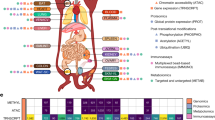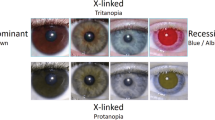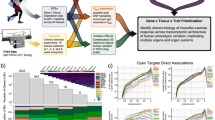Abstract
You come onto the court prepared for tennis but your partner seems to be ready for rugby. Neither of you is at all sure what it is that your opponent wants to play. The only recourse is to teach each other the rules of your own game and then decide whether you can collectively invent a new sport. Welcome to the dialogue at the intersections of epidemiology with genetics and genomics.
This is a preview of subscription content, access via your institution
Access options
Subscribe to this journal
Receive 12 print issues and online access
$189.00 per year
only $15.75 per issue
Buy this article
- Purchase on Springer Link
- Instant access to full article PDF
Prices may be subject to local taxes which are calculated during checkout

Similar content being viewed by others
References
Doll, R. & Hill, A. B. A study of the aetiology of carcinoma of the lung. Br. Med. J. 2, 1271– 1286 (1952).
Beaty, T. H. & Khoury, M. J. Interface of genetics and epidemiology . Epidemiol. Rev. 22, 120– 125 (2000).
Holtzman, N. A. & Martineau, T. M. Will genetics revolutionize medicine? N. Engl. J. Med. 343, 141–144 (2000).
Perou, C. M. et al. Molecular portraits of human breast tumours. Nature 406, 747–752 ( 2000).
Vogelstein, B. et al. Allelotype of colorectal carcinomas. Science 244, 207–211 (1989).
Alon, U. et al. Broad patterns of gene expression revealed by clustering analysis of tumor and normal colon tissues probed by oligonucleotide arrays. Proc. Natl Acad. Sci. USA 96, 6745– 6750 (1999).
Prevo, L. J., Sanchez, C. A., Galipeau, P. C. & Reid, B. J. p53-mutant clones and field effects in Barrett's esophagus. Cancer Res. 59, 4784–4787 (1999).
Golub, T. R. et al. Molecular classification of cancer: class discovery and class prediction by gene expression monitoring. Science 286 , 531–536 (1999).
Hopper, J. L. et al. Population-based estimate of the average age-specific cumulative risk of breast cancer for a defined set of protein-truncating mutations in BRCA1 and BRCA2. Cancer Epidemiol. Biomarkers Prev. 8, 741–747 ( 1999).
Friedman, L. et al. The search for BRCA1. Cancer Res. 54, 6374–6382 (1994).
Struewing, J. et al. The risk of cancer associated with specific mutations of BRCA1 and BRCA2 among Ashkenazi Jews. N. Engl. J. Med. 336, 1401–1408 ( 1997).
Warner, E. et al. Prevalence and penetrance of BRCA1 and BRCA2 gene mutations in unselected Ashkenazi Jewish women with breast cancer. J. Natl Cancer Instit. 91, 1241–1247 (1999). PubMed
Peto, J. et al. Prevalence of BRCA1 and BRCA2 gene mutations in patients with early-onset breast cancer. J. Natl Cancer Inst. 91, 943–949 (1999).
Malone, K. E. et al. Frequency of BRCA1/BRCA2 mutations in a population-based sample of young breast carcinoma cases. Cancer 88, 1393–1402 (2000).
Newman, B. et al. Frequency of breast cancer attributable to BRCA1 in a population-based series of American women. J. Am. Med. Assoc. 279, 915–921 ( 1998). PubMed
Hansen, M. F. et al. Osteosarcoma and retinoblastoma: a shared chromosomal mechanism reveals recessive predisposition. Proc. Natl Acad. Sci. USA 82, 6216–6220 (1985).
Onadim, Z., Hogg, A., Baird, P. N. & Cowell, J. K. Oncogenic point mutations in exon 20 of the RB1 gene in families showing incomplete penetrance and mild expression of the retinoblastoma phenotype. Proc. Natl Acad. Sci. USA 89, 6177– 6181 (1992).
Otterson, G. A., Chen, W. -d., Coxon, A. B., Khleif, S. N. & Kaye, F. J. Incomplete penetrance of familial retinoblastoma linked to germ-line mutations that result in partial loss of RB function. Proc. Natl Acad. Sci. USA 94, 12036–12040 (1997).
MacPhee, M. et al. The secretory phospholipase A2 gene is a candidate for the Mom1 locus, a major modifier of APC Min-induced intestinal neoplasia. Cell 81, 957–966 ( 1995).
Takaku, K. et al. Intestinal tumorigenesis in compound mutant mice of both Dpc4 (Smad4) and Apc genes. Cell 92, 645–656 (1998).
Laird, P. W. et al. Suppression of intestinal neoplasia by DNA hypomethylation . Cell 81, 197–205 (1995).
Lynch, H. & de la Chapelle, A. Cancer susceptibility to non-polyposis colorectal cancer. J. Med. Genet. 36, 801–818 (1999).
Yan, H. et al. Conversion of diploidy to haploidy. Nature 403, 723–724 (2000).
Warthin, A. S. Heredity with reference to carcinoma. Arch. Int. Med. 12, 546–555 (1913).
Lynch, H. T., Lynch, P. M., Albana, W. A. & Lynch, J. F. The cancer syndrome: a status report. Dis. Col. Rect. 24, 311–322 (1981).
Coleman, M. P., Esteve, J., Damiecki, P., Arslan, A. & Renard, H. Trends in Cancer Incidence and Mortality (Oxford Univ. Press, Lyon, 1993).
Potter, J. D. Colorectal cancer: molecules and populations. J. Natl Cancer Inst. 91, 916–932 ( 1999).
Taylor, J. et al. The role of N-acetylation polymorphisms in smoking-associated bladder cancer: evidence of a gene-gene-exposure three-way interaction. Cancer Res. 58, 3603–3610 (1998).
Potter, J. D. et al. Colorectal adenomatous and hyperplastic polyps: smoking and N-Acetyltransferase 2 polymorphisms. Cancer Epidemiol. Biomarkers Prev. 8, 69–75 ( 1999).
Ulrich, C. et al. Colorectal adenomas and the C677T MTHFR polymorphism: Evidence for gene-environment interaction? Cancer Epidemiol. Biomarkers Prev. 8, 659–668 ( 1999).
Marcus, P. M. et al. Cigarette smoking, N-acetyltransferase 2 acetylation status, and bladder cancer risk: a case-series meta-analysis of a gene-environment interaction. Cancer Epidemiol. Biomarkers Prev. 9, 461–467 (2000).
Jarvik, G. Genetic predictors of common disease: apolipoprotein E genotype as a paradigm . Ann. Epidemiol. 7, 357– 362 (1997).
Altshuler, D. et al. The common PPARγ pro12Ala polymorphism is associated with decreased risk of type 2 diabetes. Nature Genet. 26, 76–79 (2000).
Sing, C. F. & Davignon, J. Role of the apolipoprotein E polymorphism in determining normal plasma lipid and lipoprotein variation. Am. J.Hum. Genet. 37, 268–285 (1985).
Author information
Authors and Affiliations
Related links
Related links
DATABASE LINKS
adenomatous polyposis of the colon
hereditary non-polyposis colorectal cancer
non-insulin-dependent diabetes mellitus
FURTHER INFORMATION
National Human Genome Research Institute's glossary of genetic terms
Glossary
- COHORT STUDY
-
Observational study of people with known levels of exposures to causal or protective agents, who are followed over a period of time; disease rates are compared between the exposed and the unexposed.
- CROSS-OVER STUDY
-
Randomized (experimental) study in which all study subjects undergo all treatments in a random order.
- CROSS-SECTIONAL STUDY
-
Observational study of characteristics of groups: often those with, versus those without, disease at a single point in time.
- FIELD EFFECT
-
Widespread molecular changes in normal or relatively normal tissue that predispose a person to cancer.
- POWER CALCULATION
-
An estimation of the ability of a given study size and design to provide a measure of relative risk within a preset limit of precision or with a preset likelihood of providing a false positive and false null finding.
- XENOBIOTICS
-
Biologically active molecules that can be ingested or inhaled and that include potential carcinogens, such as heterocyclic amines, and potentially cancer-protective compounds, such as indoles.
Rights and permissions
About this article
Cite this article
Potter, J. At the interfaces of epidemiology, genetics and genomics. Nat Rev Genet 2, 142–147 (2001). https://doi.org/10.1038/35052575
Issue Date:
DOI: https://doi.org/10.1038/35052575
This article is cited by
-
Alcohol consumption and early-onset risk of colorectal cancer in Japanese patients with Lynch syndrome: a cross-sectional study conducted by the Japanese Society for Cancer of the Colon and Rectum
Surgery Today (2018)
-
Statistical methods for quantitative mass spectrometry proteomic experiments with labeling
BMC Bioinformatics (2012)
-
Morphogens, morphostats, microarchitecture and malignancy
Nature Reviews Cancer (2007)
-
Viewpoint: using gene–environment interactions to dissect the effects of complex mixtures
Journal of Exposure Science & Environmental Epidemiology (2007)
-
Epidemiology informing clinical practice: from bills of mortality to population laboratories
Nature Clinical Practice Oncology (2005)



